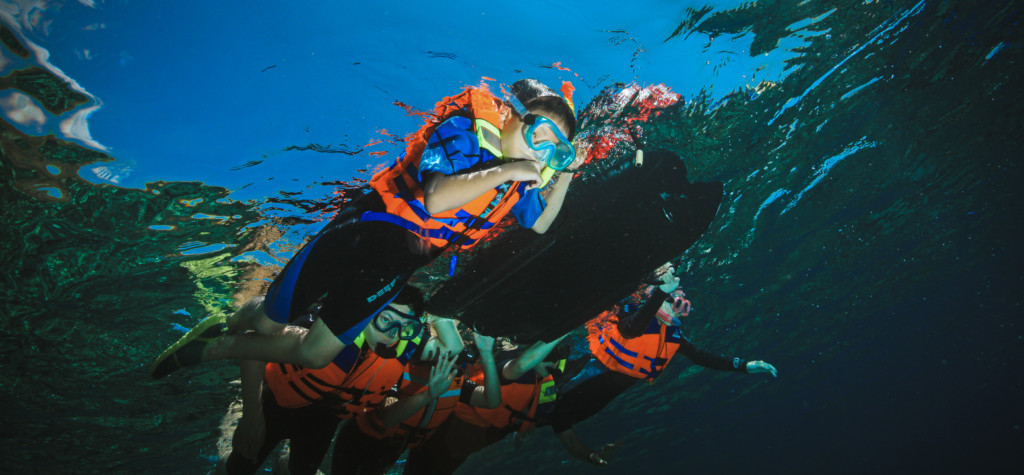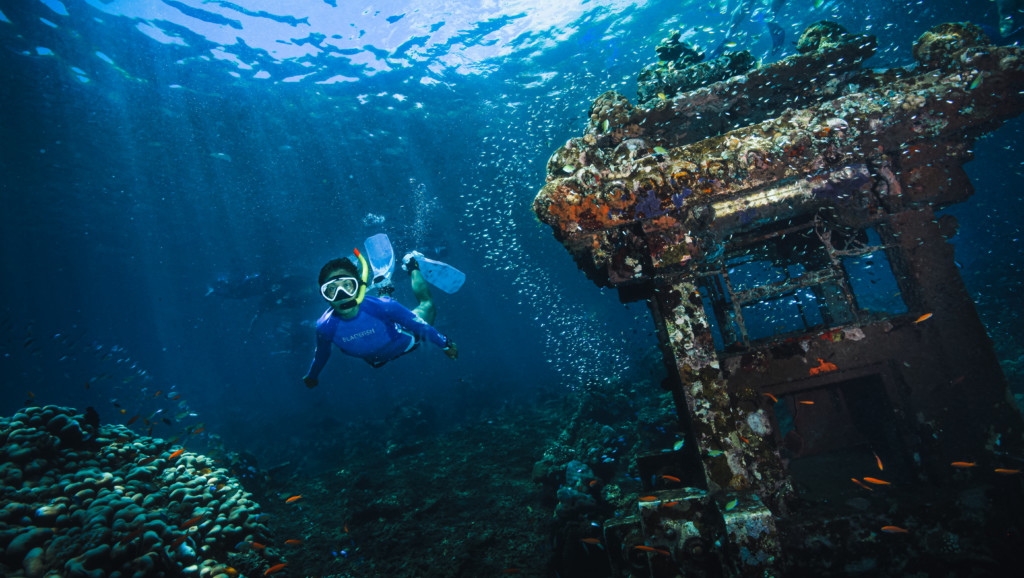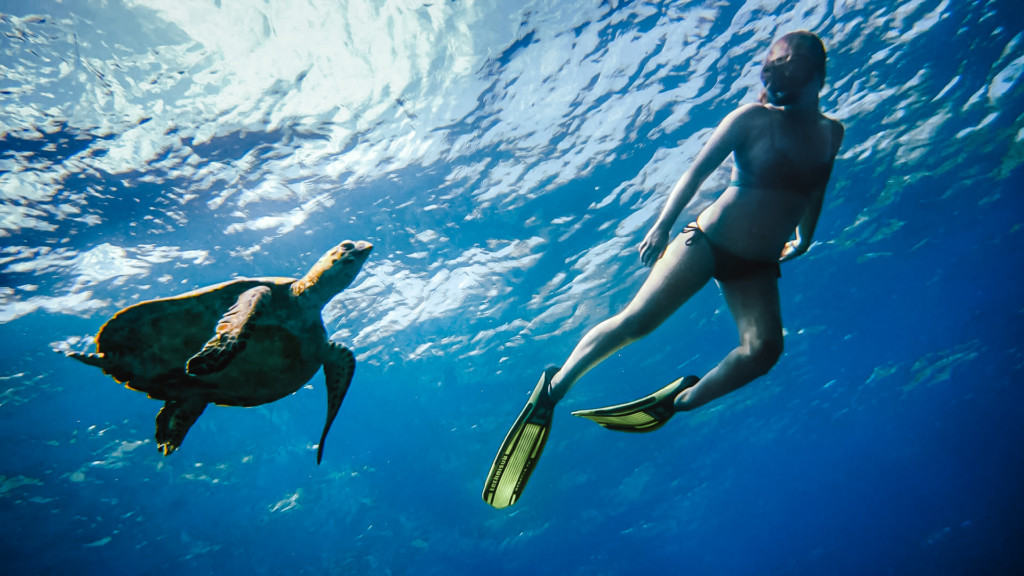Snorkeling is the activity in which you are treading the surface of the body of water using simple gears like masks, breathing tubes or snorkel, and fins. It is a simple activity that anyone who is able to swim can do and it is very popular in tropical destinations. While maybe not up close, you can encounter a lot of marine life during a snorkel like colorful tropical fishes, rays, whale sharks, and many more depends on your snorkeling location.
However, the prospect of swimming in the open ocean might be challenging for some people. Maybe you are eager to experience the underwater beauty but are not ready to take scuba directly. Or maybe you are looking for a more leisurely water activity. Here are some tips for you on how to snorkel in the ocean:

Check and get familiar with your gears
The first time you put on snorkeling gear could be an experience itself. Make sure you chose the right size to prevent water from leaking through your mask when you are snorkeling. Try your snorkel or breathing tube; suck in and blow out air to make sure they are in good condition and working properly. Remember when you put on both the mask and the snorkel, breathe through your mouth. Try on the fins and make sure they are snug but not too small on your feet. If you are snorkeling in a colder region, wearing an additional wetsuit is not a bad idea as it can help to keep you warm. And if you are not a confident swimmer, you can always opt to wear a swimming vest or to bring a flotation device of your choice.
Chose the right snorkeling spot
After the gears, the next most important thing is your snorkeling spot. Remember, when you are snorkeling, you are in the wild. There are various hazards that could endanger you if you chose the wrong snorkeling spot e.g., beaches with sharp rocks or corals, strong riptides or underwater currents, huge waves, and many more. Generally, you’ll want to snorkel in a calm, clear, and rich spot to avoid currents and riptides. It is also a good idea to do some research on your chosen snorkeling spot so set your expectations; what you can see there, what you should be wary of, and how is the landscape. Avoid spots with sharp rocks and/or coral reefs or strong waves and/or tides. You can consult with a lot of sources from the internet or simply ask the locals for the most suitable snorkeling spot for you.
Enter and exit right
Depending on the chosen location of your snorkeling trip, there are different ways to enter and exit the water.
Using Boat: Intuitively, if you joined a snorkeling tour that utilizes boats to reach the spot, you can enter the water by simply hopping in. To exit, the general rule of thumb is to exit the same pathway you enter. You can simply climb to your boat if you utilize one.
From Land: The same can’t be said if you are entering the water directly from land. Assess the environment. Sandy beaches are the easiest to tackle but you might have to swim further out as the sand will cause murky water near the shore. Beaches with sharp rocks might need some expertise to tackle. You can simply float and swim away once you are in the water. If you need to walk, be aware of the environment below you; there might be hazards like corals or sharp rocks. To exit, there might be a little more challenge compared to utilizing a boat. The most obvious challenge is waves; they could knock you around and make it harder for you to exit the water. To prevent this, swim to the point where you can stand upright then simply stand up. Your weight will once again transfer to your feet, stopping you from floating and in turn, gives you more control of your body.
Float around
Remember, your goal is to enjoy the underwater views not Olympic swimming. Snorkeling is more of a floating activity rather than swimming. Use your fins to glide and float around and keep your hands stationary on the sides of your body or stretch them in front of you. Swim at a pace that allows you to breathe normally. This is also why using a swimming vest can be a good idea as it allows you to use less of your energy.
Blow the tube
Once in a while, water can seep into your breathing tube even though you’ve made sure you kept the end of the tube above the surface. The tube is not malfunctioning and you are doing nothing wrong; this is normal. You can remove the water very easily by blowing as hard as you can into the tube. The water that seeped in will be removed then. You can also use this method when you dive deeper and submerged your breathing tube fully.
Relax and enjoy
Take slow, deep breaths when you are snorkeling. Paddle slowly with your fin. Relax away and enjoy the view. Once you are enthralled by what you saw under, everything else will come naturally. If at any point you feel panicked, simply roll over; float with your back. When you are experienced enough, take off the vests and start to dive deeper and see the marine life closer.

Other than that, there are also some important general rules you’ll have to follow to ensure your safety and the perseverance of nature during your snorkeling:
Don’t snorkel alone
Compared to scuba or even skin diving, snorkeling is a relatively safe activity. But remember, you are in the open ocean. Being alone makes you much more vulnerable to things like current or wildlife threats. If you are not a good swimmer or completely new to this, pair up with someone who has more experience or even better, join a group.
No touching
Snorkeling is also a humbling way to raise awareness of how beautiful and fragile the ocean is. You can marvel at the beauty in front of your eyes but never touch them. Even the most unsuspecting creature might be poisonous. A lot of creatures might feel threatened by you reaching out to them and could attack you. Not to mention the natural discourse you might cause if you insert yourself into the ecosystem; for example: feeding the marine life. Needless to say, definitely do not take anything with you unless it is trash.
Be aware
As mentioned before, when you are snorkeling, you are essentially in the wild. It is always a good idea to do some research about your snorkeling spot. Ask the locals if there are riptides or sharp rocks around. Be mindful of how far and deep you are going. Watch your surroundings to avoid strong currents or dangerous creatures.
Relax
Once again, relaxing is important. When you encounter a problem, simply roll over and call for help; do not flail around grabbing people as you could put them in danger too. Don’t push yourself if you are too overwhelmed by the experience; simply take one step at a time. There is no rush or pressure for you to get into the ocean.

Those are few important things you have to remember when you are snorkeling in the ocean but there is no reason you should feel discouraged to do it. The key to an enjoyable snorkeling experience is to relax and trust your gears to assist you then everything else will just fall in place. Like many other water activities, snorkeling is a lot more fun than it is dangerous. The adrenaline rush before you jump into the water is addicting and the marvelous view the underwater world offers feels much more enthralling when you see it with your own eyes.






